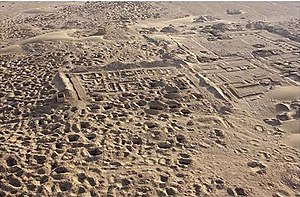
Summary
Lugalannatum (𒈗𒀭𒈾𒁺, lu-gal-an-na-tum) was a ruler ("patesi") of the city-state of Umma, circa 2130 BCE.[1]
| Lugalannatum 𒈗𒀭𒈾𒁺 | |
|---|---|
| Prince of Umma | |
 Aerial view of the ruins of Umma. | |
| Reign | fl. circa 2130 BCE |
Lugalannatum is known from a deposit tablet, now in the Louvre Museum, in which he mentions the rule of Si'um, king of the Gutians.[3][1] The tablet was first published in 1911, and first revealed the existence of a Gutian dynasty of Sumer.[2][4] The tablet is written in the Akkadian language following the influence of the former Akkadian Empire, and uses Sumerian cuneiform characters for their phonetical value.[1] It reads:
Lugal-an-na-tum/ pa-te-si/ GIS UH KI-ge/ GIS UH Kl/ ba-ba-a/ 30 + 5 mu/ sal-la-ba/ ê pa GIS UH Kl/ sal-sal/ temen-bi/ ki-a ni-si-si/ me-bi sag-ba/ si-ba-ni-sa/ ud Ba-si-û-um/ lugal Gu-ti-um kam
Lugalannatum, patesi of Umma, (as) Umma for 35 years abounded in liberalities, Ê PA, the rich temple of Umma, its foundations he established, he ensured rites inside, and set up rules, at the time of Ba-siûm, king of Gutium.
— Tablet of Lugalannatum[2]
The name of the Temple, previously thought to be "Ê PA Temple", is now understood as being "Scepter Temple", and read E.GIDRU.[1]
The text shows the allegiance of Lugalannatum, as simple Governor of Umma, towards the Gutian king of Sumer.[5]
There is also an inscription by Lugalannatum, dedicated to the life of Urgigir.[6]
-
 The name Lugalannatum in archaic linear script, and in standard Sumero-Akkadian cuneiform (𒈗𒀭𒈾𒁺).
The name Lugalannatum in archaic linear script, and in standard Sumero-Akkadian cuneiform (𒈗𒀭𒈾𒁺). -
 Mention of Gutium in the tablet (last column: 𒄖𒋾𒌝𒆠, gu-ti-umKI)
Mention of Gutium in the tablet (last column: 𒄖𒋾𒌝𒆠, gu-ti-umKI)
References edit
- ^ a b c d e "Site officiel du musée du Louvre". cartelfr.louvre.fr.
- ^ a b c Scheil, Vincent (1911). "Une nouvelle dynastie suméro-accadienne. Les rois " Guti "". Comptes rendus des séances de l'Académie des Inscriptions et Belles-Lettres. 55 (4): 318–327. doi:10.3406/crai.1911.72837.
- ^ Sallaberger, Walther (2011). Der kultische Kalender der Ur III-Zeit (in German). Walter de Gruyter. p. 250, note 1182. ISBN 978-3-11-088925-3.
- ^ Langdon, Stephen (1913). Babylonian liturgies. Stephen Langdon. p. 93.
- ^ "From a text recently found at Jokha we also know that Lugal-annatum, patesi of Umma, Lugalannatum patesi of Umma, owed allegiance to Sium, King of Guti" Chisholm, Hugh (1913). The Britannica Year Book. Encyclopœdia Britannica Company, Limited. p. 259.
- ^ Beaulieu, Paul-Alain (2003). The Pantheon of Uruk During the Neo-Babylonian Period. BRILL. ISBN 978-90-04-13024-1.






